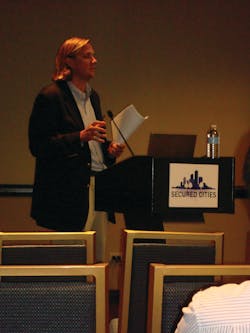Secured Cities: Finding urban security and municipal video funding
Chicago, Ill., April 23, 2012 -- The municipal video surveillance conference Secured Cities ended last week, with many takeaways for managers, end users and integrators looking to get a piece of this growing market. But the vehicles for obtaining funding have shifted and changed and the new nuances were discussed in a session called: "Grants, P3s and EPCs: Where to Find Today's City Wide Surveillance Funding."
Mark Jules, executive director of the National Public Safety Foundation (www.nationalpublicsafetyfoundation.org) said the non-profit is actively involved in helping cement Public Private Partnerships (P3s) and Energy Performance Contracts, which have become critical, key elements to securing funding for municipal video surveillance projects.
NPSF helps a variety of entities generate funds for the acquisition of technology, including public safety agencies and law enforcement departments—by helping educate the public as well.
"You'd be amazed how people don't understand how public safety agencies generate funding and why," Jules said. "We also create in-kind funds, for example we might get companies to put up matching software or technology funds that help secure the investment," he said.
Learn to work in tandem with others
Jules said his foundation often finds that various agencies within a city or organization don't talk or communicate with each other. Those communication paths need to be opened, he said, because the ability to gather funds is all about "how you use your own resources and each other's resources."
"Matching grants are critical today. Traditional funding sources, such as state and federal grants, used to be in the billions and today they are in the millions and many more are performance-based," he said. Two critical areas that require an in-depth understanding are the importance of Public Private Partnerships and Energy Performance Contracts, which are now supplementing other forms of funding.
Jules said Energy Performance Contract funding is one of the best kept secrets for obtaining money for technology projects. The caveat is that "Performance based and energy performance grants take an incredibly long time to implement—from 18 to 24 months. New energy performance contract grants consider energy efficiency, lighting, HVAC and also, public safety," he said. For cities and municipalities, he added, for every $1 spent on public safety to prevent crime, cities might see savings of $4 if you factor in court costs.
Other tips from the session included:
Your city will score better and perhaps achieve funding if you can get together with multiple agencies, such as HUD or transportation departments, for example, to secure funds.
Show successes and how other monies have been spent to help the public or other agencies.
Focus on partnerships for maximum benefit, and demonstrate how the entire city, location or agency will benefit. For example, how do you make computer-aided dispatch so that it can be integrated with other systems to make it more exponentially valuable? Make sure your vendors have open systems, open APIs and SDKs and that systems are upgradeable, flexible and allow for mobility within the infrastructure.
Make sure the maximum number of people and agencies will be able to use the systems,
"We have to get out of the habit of applying for separate funding, and instead, we have to think about how we build an infrastructure that will help everyone achieve smarter, safer, more efficient cities," Jules concluded.
Photo caption:
Public private partnerships and new energy performance contracts are key areas where funding may be more readily available, according to Mark Jules, executive director of the National Public Safety Foundation. Photo: Deborah O'Mara
About the Author

